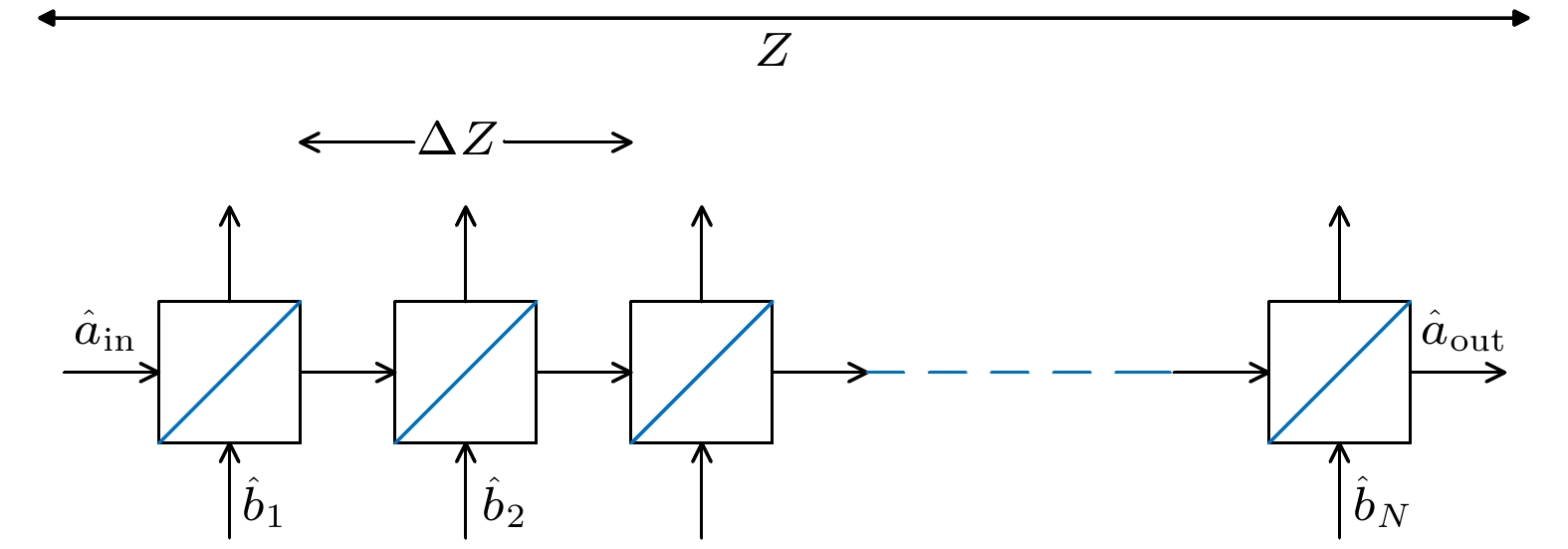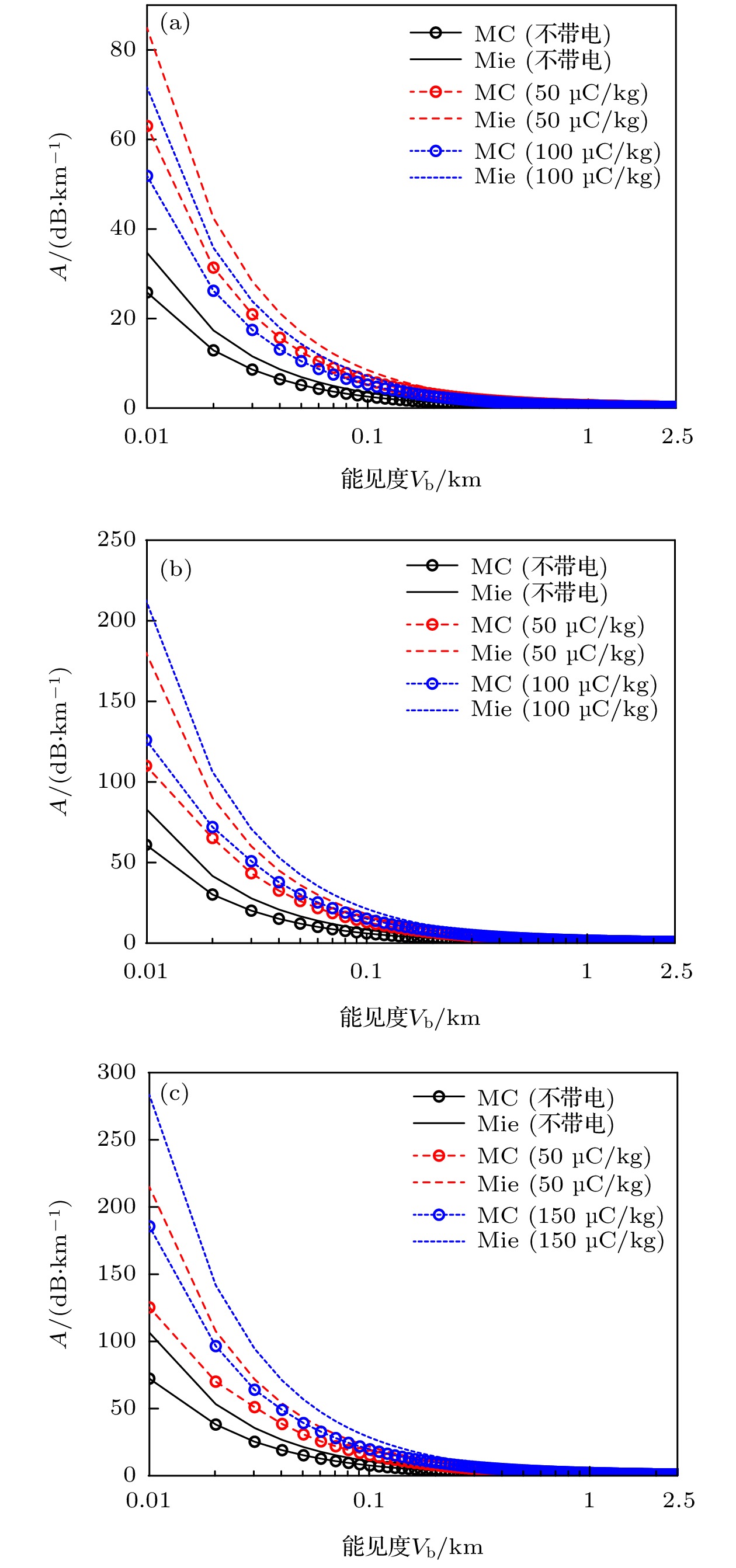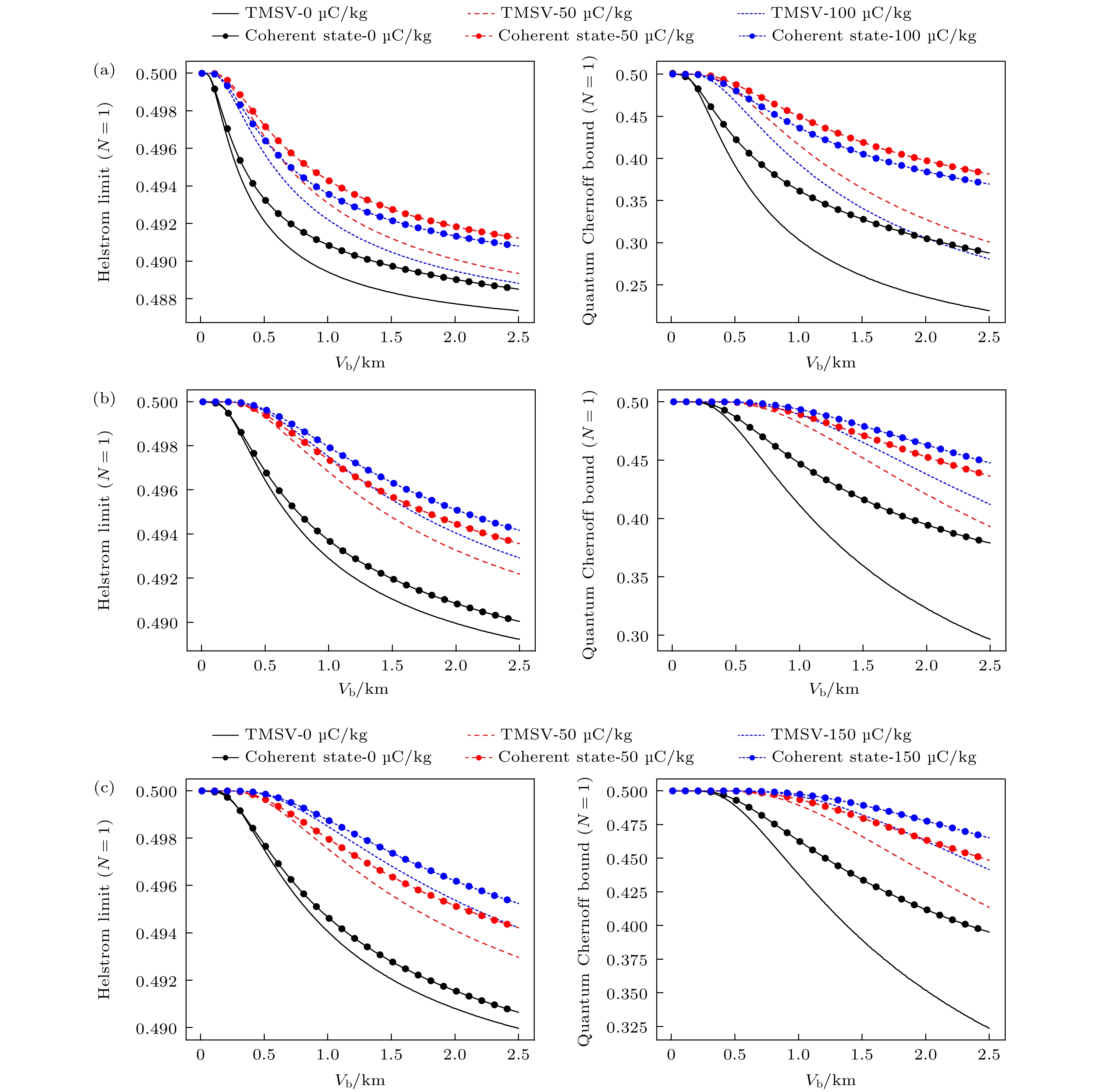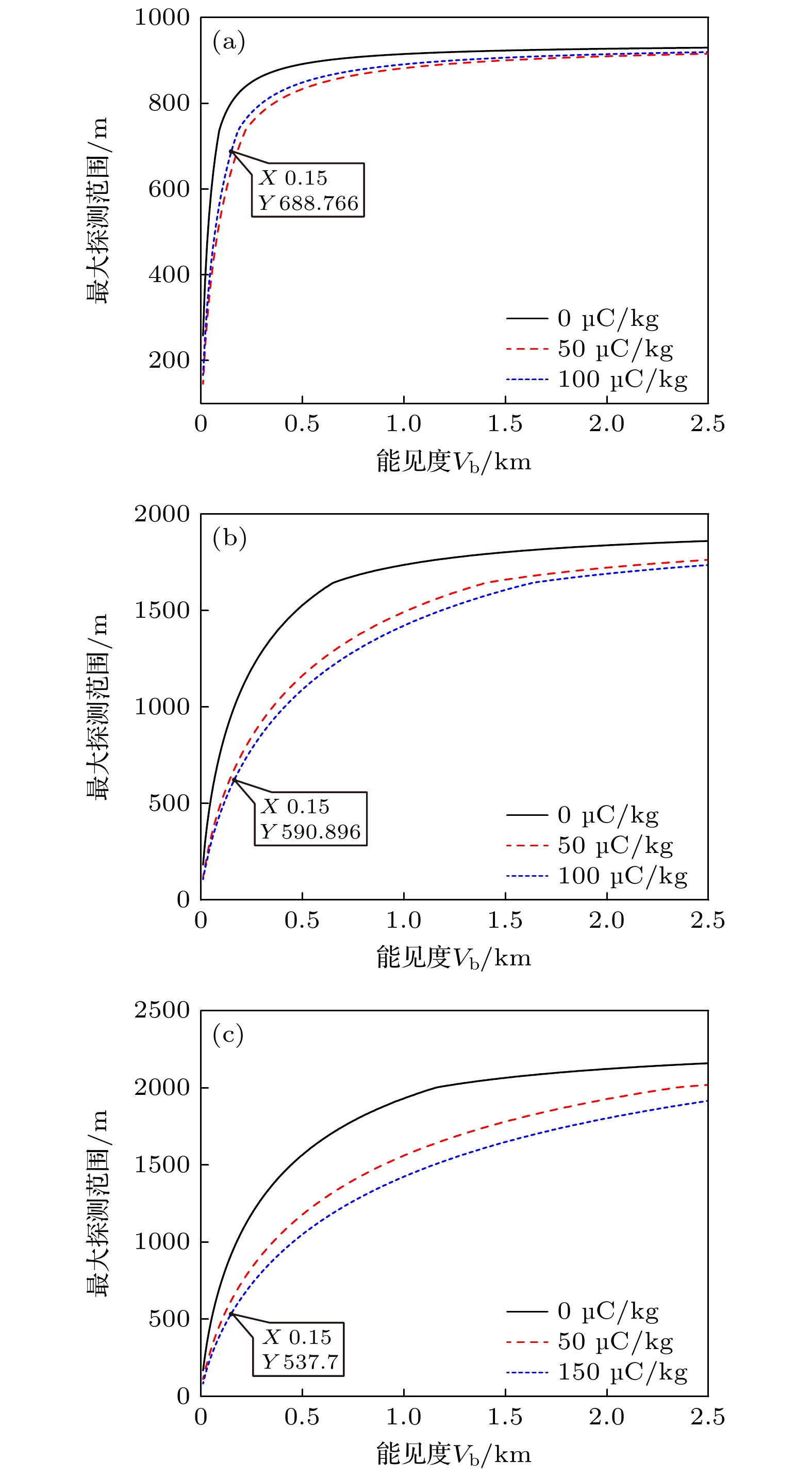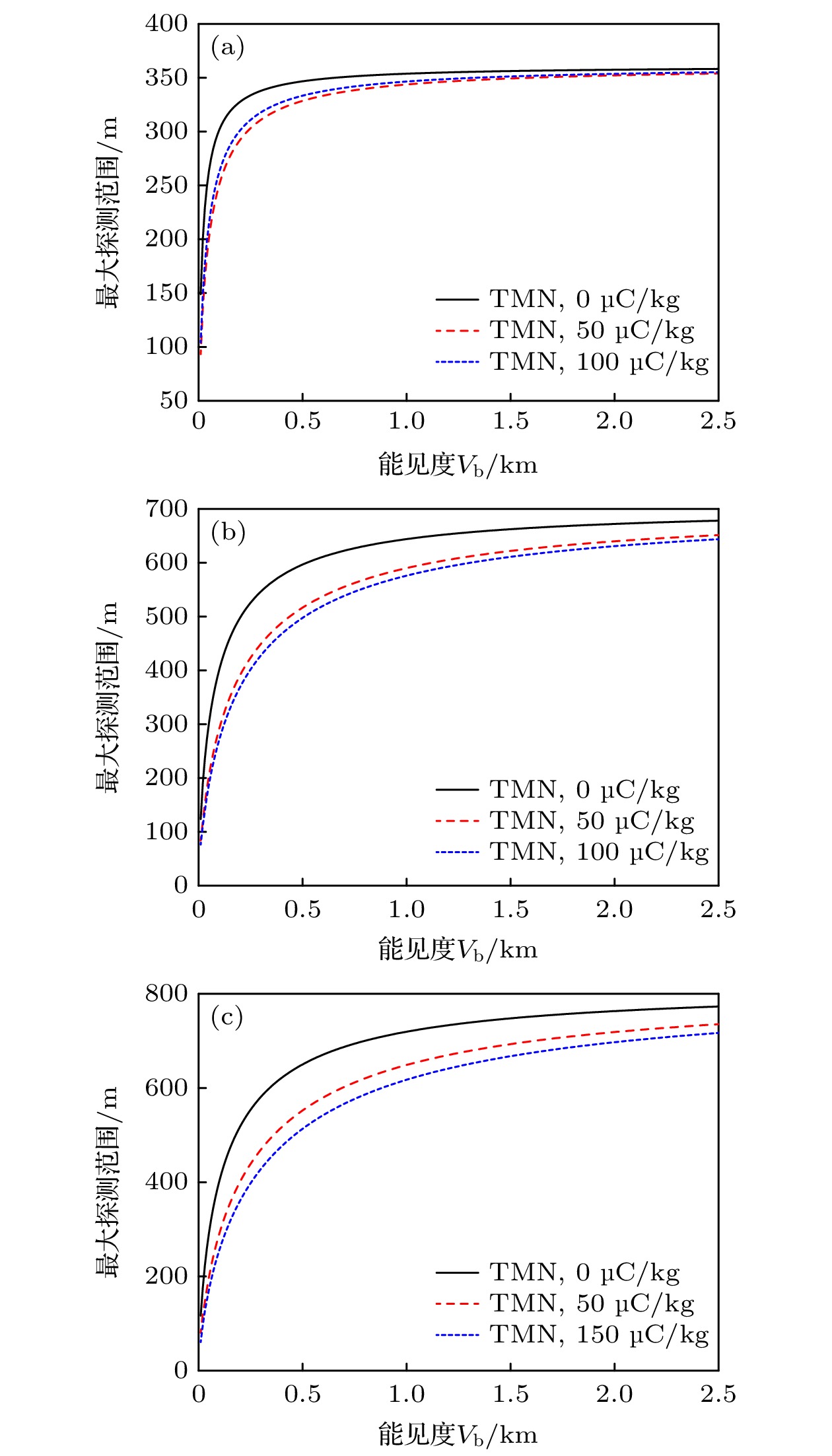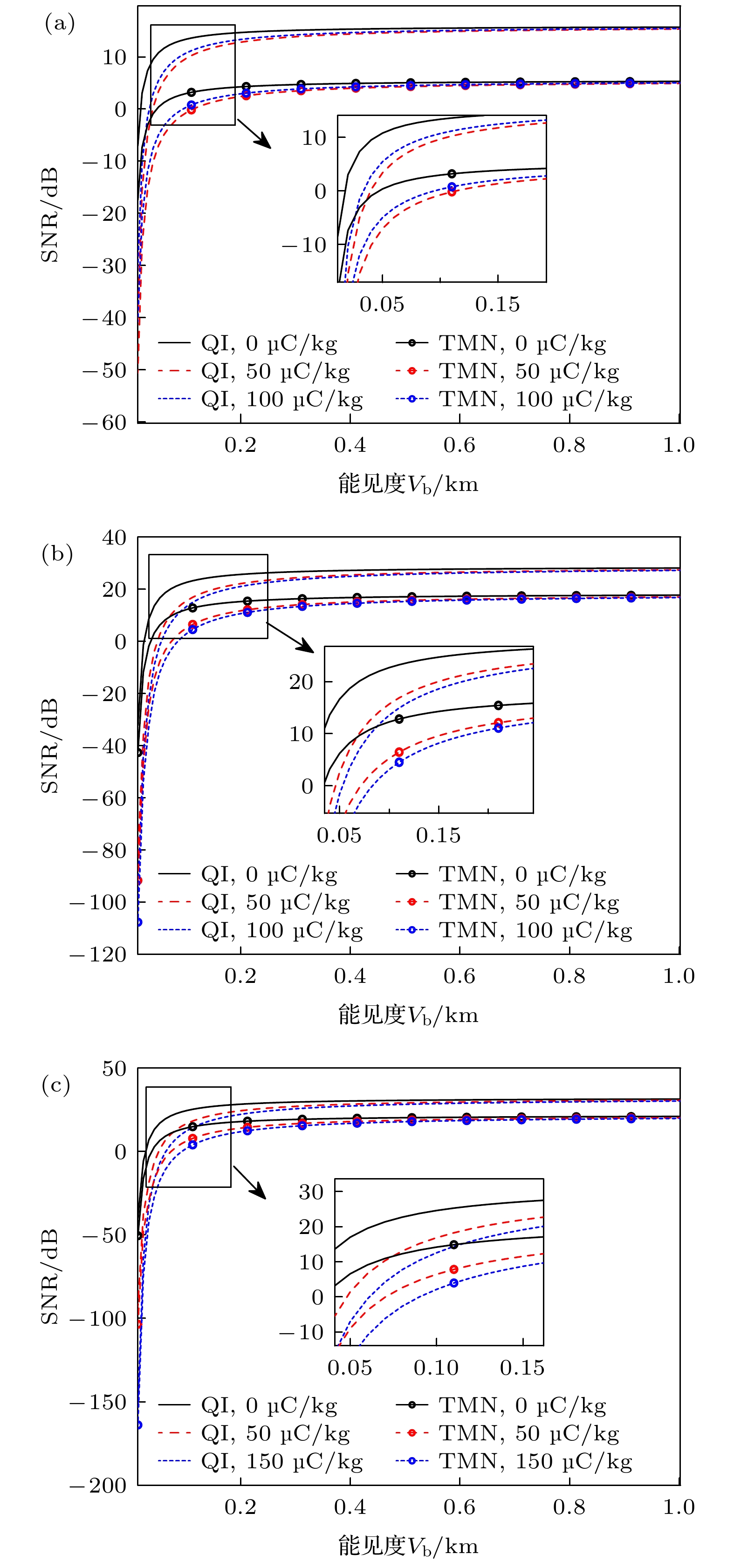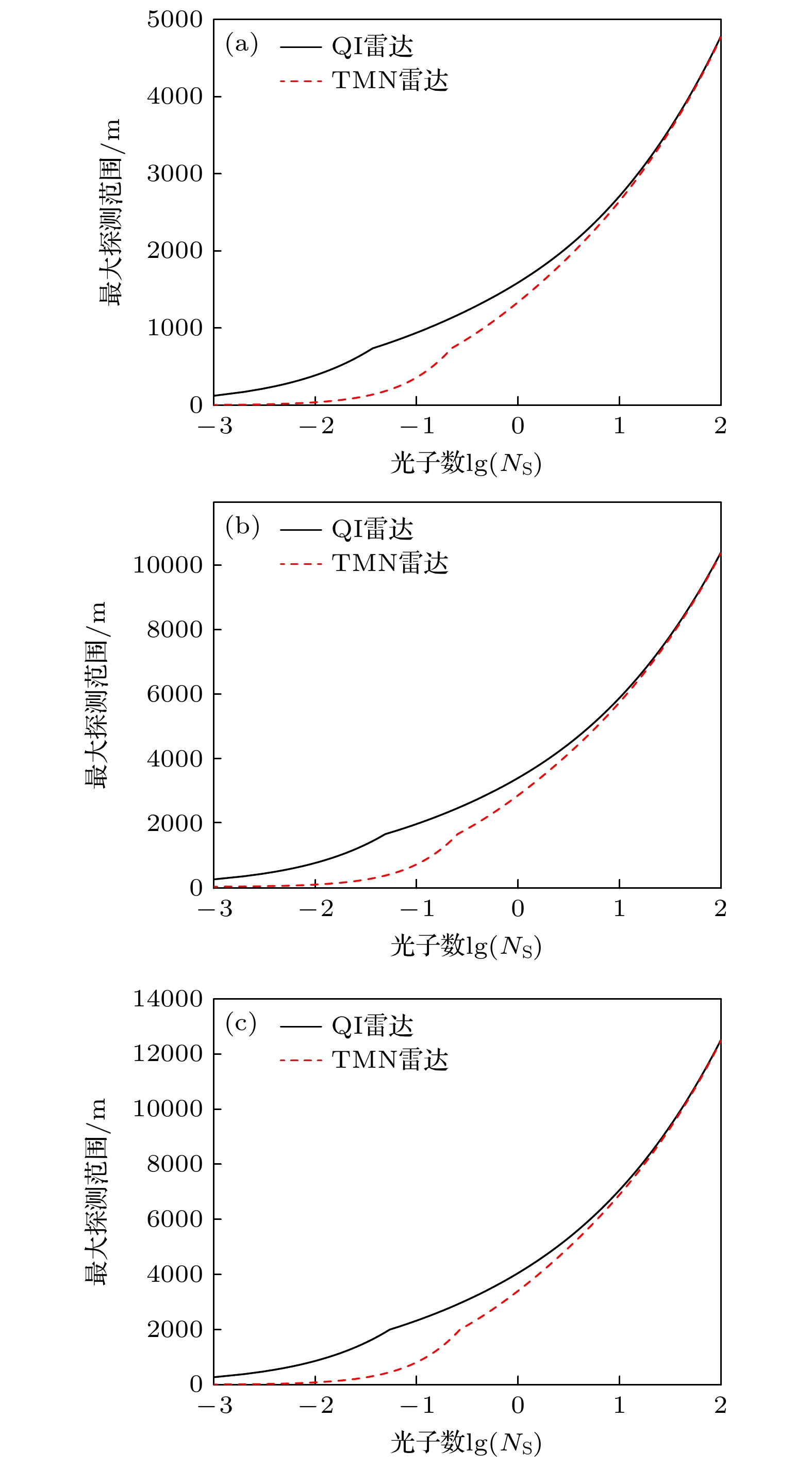-
本文旨在研究带电沙尘大气对微波量子照明雷达性能的影响. 基于Mie粒子散射理论, 运用模拟离散随机分布粒子对光子多重散射的蒙特卡罗方法, 对不同能见度及不同粒子带电量的沙尘大气的微波衰减进行分析. 根据量子照明雷达理论, 采用基于分束器理论的分光链路模型模拟沙尘大气信道, 并根据量子雷达方程及量子检测错误概率理论, 开展不同能见度带电沙尘大气对微波量子照明雷达的检测错误概率、信噪比和最大探测范围等影响研究, 并与经典TMN雷达性能进行对比分析. 结果表明, 在沙尘大气中, 量子照明雷达的性能随着能见度的增大而提高, 粒子带电会引起信号衰减增大及系统性能下降, 带电量的变化引起性能的改变是非线性的. 当能见度较高时适当提高信号频率可提高量子照明雷达的性能, 当能见度较低时频率提高带来的增益会小于衰减增大带来的性能下降, 这种情况不宜增大频率. 在与经典雷达的比较发现, 在较低能见度及较低发射平均光子数时量子雷达性能较优, 但随着光子数增加, 优势逐渐降低.
This work is to study the effects of charged sand/dust atmosphere on the performances of microwave quantum illumination (QI) radar. Based on Mie particle scattering theory, using a Monte Carlo method for simulating the physical process in which photon is scattered multiple times by discrete random distributed particles, the specific attenuation (dB/km) of microwave propagating in sand/dust atmosphere are analyzed under the conditions of varying atmospheric visibility and sand/dust particles with different charged quantities. It is indicated that the specific attenuation obtained by multiple scattering is smaller than that obtained based on Mie theory, for microwave propagating in charged sand/dust atmosphere. The smaller the atmospheric visibility, the greater the difference is, while the difference decreases gradually as the atmospheric visibility increases. Then, it is more reasonable to consider multiple scattering attenuation at lower atmospheric visibility. When sand/dust particle is charged, the specific attenuation is increased, however, this increase is not linear. According to quantum illumination radar theory, a beam splitter-based optical link model is used to simulate the sand/dust atmospheric channel. The effects of charged sand/dust atmosphere with different visibility on the detection error probability, signal-to-noise ratio, and maximum detection range for microwave quantum illumination radar are studied by using quantum radar equation and quantum detection error probability theory. The performances between QI radar and classical two-mode noise (TMN) radar are compared and analyzed. These results show that the performances of quantum illumination radar are improved with sand/dust atmospheric visibility increasing. When sand/dust particles are charged, the performances for QI radar are degraded due to attenuation increasing. The change in the performance is nonlinear with the variation of sand/dust carrying charge quantity. When visibility is high, increasing the signal frequency can improve the performance of quantum illumination radar, but when visibility is low, the gain of frequency increase is offset by the performance decline caused by attenuation increase. Therefore, it is not recommended to increase the frequency in such a case. The comparison with classical radar reveals that QI radar performs better under the condition of lower atmospheric visibility and lower average photon emission, but this advantage diminishes as the number of photons increases. In a word, these results show that the performances of QI radar are more significant at lower atmospheric visibility. Under higher visibility conditions, the QI system SNR can be improved by increasing frequency. The maximum detection range of the QI radar is significantly better than that of the classical TMN radar. -
Keywords:
- quantum illumination radar /
- sand/dust atmosphere /
- detection performance /
- multiple scattering
[1] Lloyd S 2008 Science 321 1463
 Google Scholar
Google Scholar
[2] Lanzagorta M 2011 Quantum Radar (San Rafael: Morgan & Claypool publishers) pp1–2
[3] Lopaeva E D, Berchera I R, Degiovanni I P, Olivares S, Brida G, Genovese M 2013 Phys. Rev. Lett. 110 153603
 Google Scholar
Google Scholar
[4] Shapiro J H, Zhang Z, Wong F N C 2014 Quantum Inf. Process. 13 2171
 Google Scholar
Google Scholar
[5] 任益充, 王书, 饶瑞中, 苗锡奎 2018 物理学报 67 140301
 Google Scholar
Google Scholar
Ren Y C, Wang S, Rao R Z, Miao X K 2018 Acta Phys. Sin. 67 140301
 Google Scholar
Google Scholar
[6] Sharma P, Mishra K M, Mishra D K 2024 J. Opt. Soc. Am. B 41 6
[7] Barzanjeh S, Guha S, Weedbrook C, Vitali D, Shapiro J H, Pirandola S 2015 Phys. Rev. Lett. 114 080503
 Google Scholar
Google Scholar
[8] Miao Q, Li X, Wu D W, Luo J W, Wei T L, Zhu H N 2019 Acta Phys. Sin. 68 070302 (in Chinse) [苗强, 李响, 吴德伟 2019 物理学报 68 070302]
 Google Scholar
Google Scholar
Miao Q, Li X, Wu D W, Luo J W, Wei T L, Zhu H N 2019 Acta Phys. Sin. 68 070302 (in Chinse)
 Google Scholar
Google Scholar
[9] Barzanjeh S, Pirandola S, Vitali D 2020 Sci. Adv. 6 eabb0451
 Google Scholar
Google Scholar
[10] Livreri P, Enrico E, Fasolo L 2022 Microwave quantum radar using a Josephson traveling wave parametric amplifier. In: Proceedings of the 2022 IEEE Radar Conference (Radar Conf22) New Yorky, USA, March 21–25, 2022 pp1–5
[11] Wei R Y, Li J, Wang W H, Ye Z, Zhao C L, Guo Q H 2023 IET Radar Sonar Navig. 17 1664
 Google Scholar
Google Scholar
[12] Borderieux S, Coatanhay A, Khenchaf A 2023 Prog. Electromagn. Res. B. 103 101
 Google Scholar
Google Scholar
[13] Lanzagorta M 2015 Proceedings of SPIE—Radar Sensor Technology XIX and Active and Passive Signatures VI 9461 946113
[14] Goldhirsh J 1982 IEEE Trans. Antennas Propag. 30 1121
 Google Scholar
Google Scholar
[15] Ghobrial S, Sharief S 1987 IEEE Trans. Antennas Propag. 35 418
 Google Scholar
Google Scholar
[16] Yang R K, Li Q Q, Yao R H 2016 Acta Phys. Sin. 65 094205 (in Chinse) [杨瑞科, 李茜茜, 姚荣辉 2016 物理学报 65 094205]
 Google Scholar
Google Scholar
Yang R K, Li Q Q, Yao R H 2016 Acta Phys. Sin. 65 094205 (in Chinse)
 Google Scholar
Google Scholar
[17] Dong X Y, Chen H Y, Guo D H 2011 IEEE Antennas Wireless Propag. Lett. 10 469
 Google Scholar
Google Scholar
[18] Dong Q F, Xu J D, Li Y L 2011 J. Infrared Milli. TE. 32 55
 Google Scholar
Google Scholar
[19] Wang J, Li X, Wang M 2019 Theor. Appl. Climatol. 137 3
[20] Xie L, Gao X B, Qin J H, Zhou J 2020 J. Quant. Spectrosc. Ra. 251 107040
 Google Scholar
Google Scholar
[21] Stephen M B, John J, Alessandra G 1998 Phys. Rev. A. 57 3
[22] Tao Z W, Ren Y C, Aiziguli A B K, Liu S W, Rao R Z 2021 Acta Phys. Sin. 70 170601 (in Chinse) [陶志炜, 任益充, 艾则孜姑丽·阿不都克热木, 刘世韦, 饶瑞中 2021 物理学报 70 170601]
 Google Scholar
Google Scholar
Tao Z W, Ren Y C, Aiziguli A B K, Liu S W, Rao R Z 2021 Acta Phys. Sin. 70 170601 (in Chinse)
 Google Scholar
Google Scholar
[23] Usha Devi A R, Rajagopal A K 2009 Phys. Rev. A 79 062320
 Google Scholar
Google Scholar
[24] Calsamiglia J, Munoz-Tapia R, Masanes L 2008 Phys. Rev. A 77 032311
 Google Scholar
Google Scholar
[25] Jeffers J R, Imoto N, Loudon R 1993 Phys. Rev. A 47 4 3346
[26] Dong Q S 1997 Chin. J. Radio Sci. 1 15 (in Chinse) [董庆生 1997 电波科学学报 1 15]
Dong Q S 1997 Chin. J. Radio Sci. 1 15 (in Chinse)
[27] Li S G, Liu X D, Hou L T. 2003 Appl. d Laser 2 23 (in Chinse) [李曙光, 刘晓东, 侯蓝田 2003 应用激光 2 23]
 Google Scholar
Google Scholar
Li S G, Liu X D, Hou L T. 2003 Appl. d Laser 2 23 (in Chinse)
 Google Scholar
Google Scholar
[28] Qu J J, Yan M H, Dong G R 2003 Sci. China Earth Sci. 33 593 (in Chinse) [屈建军, 言穆弘, 董光荣 2003 中国科学D辑 33 593]
Qu J J, Yan M H, Dong G R 2003 Sci. China Earth Sci. 33 593 (in Chinse)
[29] Zheng X., Li X C, Xie L 2011 J. Desert Res. 3 567 (in Chinse) [郑晓静, 李兴财, 谢莉 2011 中国沙漠 3 567]
Zheng X., Li X C, Xie L 2011 J. Desert Res. 3 567 (in Chinse)
[30] Dong Q S, Zhao Z W, Cong H J 1996 Chin. J. Radio. Sci. 11 29 (in Chinse) [董庆生, 赵振维, 丛洪军 1996 电波科学学报 11 29]
Dong Q S, Zhao Z W, Cong H J 1996 Chin. J. Radio. Sci. 11 29 (in Chinse)
-
表 1 量子照明雷达检测错误概率仿真参数表
Table 1. Simulation parameters for detection-error-probability in quantum illumination radar.
发射信号平均
光子数${N_{\text{S}}}$热噪声平均
光子数$ {N_{\text{B}}} $目标物体
反射率$\eta $最大截断
维度${n_{\max }}$用于探测的纠缠
光源拷贝数$N$目标到量子照明雷达
的距离z/km0.5 1 0.01 30 1 5 表 2 量子照明雷达和经典雷达输出信噪仿真参数表
Table 2. Simulation parameters for output signal-to-noise ratio of quantum illumination radar and classical radar.
信号源每个模式的
平均光子数 ${N_{\text{S}}}$热噪声
温度 T/K量子噪声
Nq接收与发射机
增益${G_{\text{r}}}$和${G_{\text{t}}}$/dB接收机
带宽$W$目标的量子雷达
散射截面/m2目标到量子照明
雷达距离 z/km信号源的中心
频率 f/GHz0.1 3 0.5 40 $f/5$ 40 1 35, 78, 95 -
[1] Lloyd S 2008 Science 321 1463
 Google Scholar
Google Scholar
[2] Lanzagorta M 2011 Quantum Radar (San Rafael: Morgan & Claypool publishers) pp1–2
[3] Lopaeva E D, Berchera I R, Degiovanni I P, Olivares S, Brida G, Genovese M 2013 Phys. Rev. Lett. 110 153603
 Google Scholar
Google Scholar
[4] Shapiro J H, Zhang Z, Wong F N C 2014 Quantum Inf. Process. 13 2171
 Google Scholar
Google Scholar
[5] 任益充, 王书, 饶瑞中, 苗锡奎 2018 物理学报 67 140301
 Google Scholar
Google Scholar
Ren Y C, Wang S, Rao R Z, Miao X K 2018 Acta Phys. Sin. 67 140301
 Google Scholar
Google Scholar
[6] Sharma P, Mishra K M, Mishra D K 2024 J. Opt. Soc. Am. B 41 6
[7] Barzanjeh S, Guha S, Weedbrook C, Vitali D, Shapiro J H, Pirandola S 2015 Phys. Rev. Lett. 114 080503
 Google Scholar
Google Scholar
[8] Miao Q, Li X, Wu D W, Luo J W, Wei T L, Zhu H N 2019 Acta Phys. Sin. 68 070302 (in Chinse) [苗强, 李响, 吴德伟 2019 物理学报 68 070302]
 Google Scholar
Google Scholar
Miao Q, Li X, Wu D W, Luo J W, Wei T L, Zhu H N 2019 Acta Phys. Sin. 68 070302 (in Chinse)
 Google Scholar
Google Scholar
[9] Barzanjeh S, Pirandola S, Vitali D 2020 Sci. Adv. 6 eabb0451
 Google Scholar
Google Scholar
[10] Livreri P, Enrico E, Fasolo L 2022 Microwave quantum radar using a Josephson traveling wave parametric amplifier. In: Proceedings of the 2022 IEEE Radar Conference (Radar Conf22) New Yorky, USA, March 21–25, 2022 pp1–5
[11] Wei R Y, Li J, Wang W H, Ye Z, Zhao C L, Guo Q H 2023 IET Radar Sonar Navig. 17 1664
 Google Scholar
Google Scholar
[12] Borderieux S, Coatanhay A, Khenchaf A 2023 Prog. Electromagn. Res. B. 103 101
 Google Scholar
Google Scholar
[13] Lanzagorta M 2015 Proceedings of SPIE—Radar Sensor Technology XIX and Active and Passive Signatures VI 9461 946113
[14] Goldhirsh J 1982 IEEE Trans. Antennas Propag. 30 1121
 Google Scholar
Google Scholar
[15] Ghobrial S, Sharief S 1987 IEEE Trans. Antennas Propag. 35 418
 Google Scholar
Google Scholar
[16] Yang R K, Li Q Q, Yao R H 2016 Acta Phys. Sin. 65 094205 (in Chinse) [杨瑞科, 李茜茜, 姚荣辉 2016 物理学报 65 094205]
 Google Scholar
Google Scholar
Yang R K, Li Q Q, Yao R H 2016 Acta Phys. Sin. 65 094205 (in Chinse)
 Google Scholar
Google Scholar
[17] Dong X Y, Chen H Y, Guo D H 2011 IEEE Antennas Wireless Propag. Lett. 10 469
 Google Scholar
Google Scholar
[18] Dong Q F, Xu J D, Li Y L 2011 J. Infrared Milli. TE. 32 55
 Google Scholar
Google Scholar
[19] Wang J, Li X, Wang M 2019 Theor. Appl. Climatol. 137 3
[20] Xie L, Gao X B, Qin J H, Zhou J 2020 J. Quant. Spectrosc. Ra. 251 107040
 Google Scholar
Google Scholar
[21] Stephen M B, John J, Alessandra G 1998 Phys. Rev. A. 57 3
[22] Tao Z W, Ren Y C, Aiziguli A B K, Liu S W, Rao R Z 2021 Acta Phys. Sin. 70 170601 (in Chinse) [陶志炜, 任益充, 艾则孜姑丽·阿不都克热木, 刘世韦, 饶瑞中 2021 物理学报 70 170601]
 Google Scholar
Google Scholar
Tao Z W, Ren Y C, Aiziguli A B K, Liu S W, Rao R Z 2021 Acta Phys. Sin. 70 170601 (in Chinse)
 Google Scholar
Google Scholar
[23] Usha Devi A R, Rajagopal A K 2009 Phys. Rev. A 79 062320
 Google Scholar
Google Scholar
[24] Calsamiglia J, Munoz-Tapia R, Masanes L 2008 Phys. Rev. A 77 032311
 Google Scholar
Google Scholar
[25] Jeffers J R, Imoto N, Loudon R 1993 Phys. Rev. A 47 4 3346
[26] Dong Q S 1997 Chin. J. Radio Sci. 1 15 (in Chinse) [董庆生 1997 电波科学学报 1 15]
Dong Q S 1997 Chin. J. Radio Sci. 1 15 (in Chinse)
[27] Li S G, Liu X D, Hou L T. 2003 Appl. d Laser 2 23 (in Chinse) [李曙光, 刘晓东, 侯蓝田 2003 应用激光 2 23]
 Google Scholar
Google Scholar
Li S G, Liu X D, Hou L T. 2003 Appl. d Laser 2 23 (in Chinse)
 Google Scholar
Google Scholar
[28] Qu J J, Yan M H, Dong G R 2003 Sci. China Earth Sci. 33 593 (in Chinse) [屈建军, 言穆弘, 董光荣 2003 中国科学D辑 33 593]
Qu J J, Yan M H, Dong G R 2003 Sci. China Earth Sci. 33 593 (in Chinse)
[29] Zheng X., Li X C, Xie L 2011 J. Desert Res. 3 567 (in Chinse) [郑晓静, 李兴财, 谢莉 2011 中国沙漠 3 567]
Zheng X., Li X C, Xie L 2011 J. Desert Res. 3 567 (in Chinse)
[30] Dong Q S, Zhao Z W, Cong H J 1996 Chin. J. Radio. Sci. 11 29 (in Chinse) [董庆生, 赵振维, 丛洪军 1996 电波科学学报 11 29]
Dong Q S, Zhao Z W, Cong H J 1996 Chin. J. Radio. Sci. 11 29 (in Chinse)
计量
- 文章访问数: 3642
- PDF下载量: 51
- 被引次数: 0













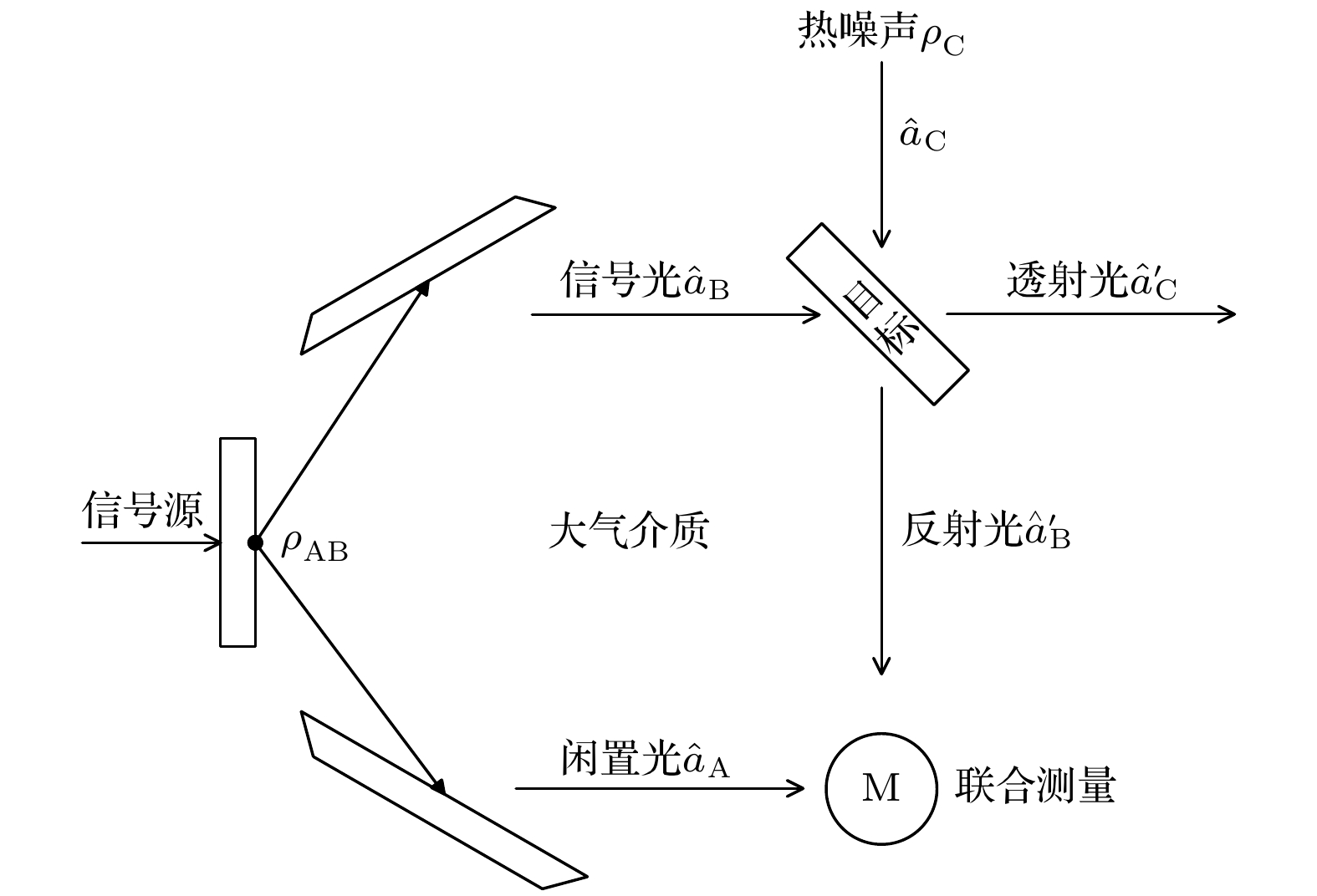
 下载:
下载:
